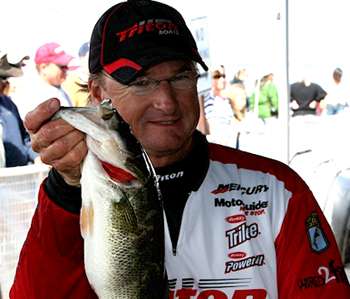
Bass may not be tall, but they usually like to have something over their heads — vegetation or other cover is preferable — and under all circumstances they want to keep their backs wet. So falling water makes them nervous. Whether it be because of hydroelectric generation, tidal flow or some other reason, it's necessary to adjust with the outflow or you'll be left with an empty livewell.
Veteran Texas pro Gary Klein has three decades of history adjusting with skittish fish and rapidly changing water levels. This year he was able to parlay that experience into a check when the Elite Series stopped at Lake Guntersville. Their arrival had been preceded by massive storms, and water was flowing into the lake faster than the Tennessee Valley Authority could let it out.
"I knew that I was going to be fishing for postspawn fish coming into this event," Klein says. "What really played right into my hands was that we had a tremendous amount of current coming into the lake. It was the first time in my entire career that I fished Lake Guntersville with this amount of current, not only in the upriver section but in the entire lake."
While some anglers would presume falling water would push the fish deep instantaneously, Klein was committed to several fairly shallow schools of bass. "Every fish I caught was in less than 3 feet of water," Klein says. "I fished in the muddy water, and that pretty much eliminated all of the other boat traffic. That's golden when you get to fish on a lake that good, with that many anglers on it, and you get the opportunity to fish an area all by yourself. What that gave me the opportunity to do was relax a little bit. I didn't have to be as thorough with the fish that I had found."
While he may not have needed to fish in his typical methodical fashion, he still had to adjust as the tournament progressed. In this case, that meant a bait change and a slight location change. "I had the opportunity to stay with the fish as they moved throughout the course of the week," he says. "In the first two days, the water dropped about 18 inches. It really moved the bass and forced them out to the flats and out to the breakline. They were still relating to current, but they just moved offshore a little further.
I had to relocate one of my best schools from the beginning of the week about 500 yards away. As the water fell out from underneath them, they were forced to adjust." A move of that distance is not significant for a pack of hungry bass, Klein says. He believes that feeding fish are highly mobile and that "it's nothing for a fish to move a mile. They can go all the way from the backs of the creek to the mouth in a very short time."
Once he relocated the school, he also chose a different tool in order to maximize the bite. "The first two days my primary bait was a 3/8-ounce white spinnerbait in shallow water," he says. "The blades would catch, I'd engage the reel and I'd see the water boil. It was so much fun, and it was that easy. But by midday on the second day, and all day on the third, I was catching my fish on a square-bill crankbait. I had to move out to that 2- to 4-foot range instead of staying up in the zero- to 3-foot range." It wasn't a huge move, nor was the change in depth substantial, and while the water dropped, Klein refused to let the bottom drop out of his tournament plan.





